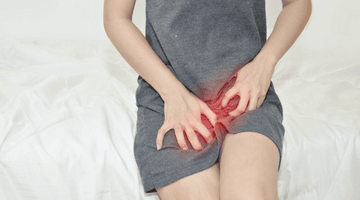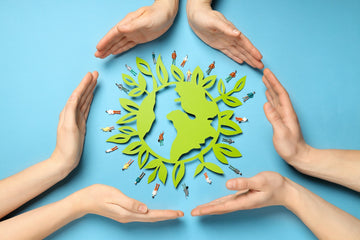Having your period is a normal part of life for girls and women, but talking about it can sometimes feel awkward, especially in India where many still shy away from open chats about menstruation. Why is keeping clean during your period so important? How can good hygiene make you feel better and more confident? This easy-to-read guide answers these questions with practical tips to help you manage your period safely and comfortably.
Whether you’re a young girl just starting your periods or someone looking to learn more, this blog is here to help you feel confident about period care. Plus, find out how Padforher’s products, like our Pain Relief Roll-On, can make your periods easier. Let’s break the silence and make period care simple and stress-free!
What Are Periods and Why Do They Happen?
Periods are when your body sheds the lining of your womb if there’s no pregnancy. They usually come every 28–35 days and last 2–7 days. Most girls get their first period (called menarche) between ages 11 and 14, but it can vary. Ever wondered why your periods sometimes change or why they hurt?
Things like stress, food, or exercise can make your period come early or late, or change how heavy it is. Some pain or cramps (called dysmenorrhea in doctor-speak) are normal, but if the pain is too much, it’s a good idea to talk to a doctor. Keeping track of your periods with a calendar can help you know what’s normal for you. Want to start tracking? Grab our free Period Tracker Template to make it easy!
Fun Fact: Did you know 1 in 10 girls in India miss school during their period because they don’t have pads or other products? UNICEF says this, and it shows why learning about periods is so important. Got a period question you’re shy to ask? Drop it in the comments below, and let’s talk openly!

Why Period Hygiene Matters
Keeping clean during your period isn’t just about feeling fresh—it’s about staying healthy. If you don’t change your pads or wash properly, germs can grow and cause problems like rashes, itches, or even infections like urinary tract infections (UTIs). In rare cases, leaving a tampon in too long can lead to a serious issue called toxic shock syndrome (TSS).
Good hygiene also helps you feel good about yourself. Not having enough pads or feeling unprepared can make you stressed or embarrassed, which isn’t fun. In India, many girls face “period poverty”—not having money to buy pads or tampons—which can make things harder. Good period care keeps you healthy, happy, and ready to take on your day.
Want to make your periods easier? Read on for simple tips and check out Padforher’s products to stay comfortable.
5 Easy Period Hygiene Tips for Every Girl
Taking care of your period doesn’t have to be hard. Here are five simple tips to keep you clean and confident:
-
Change Your Pads or Tampons Often
Swap out pads or tampons every 4–6 hours to keep things fresh and avoid germs. If you use a menstrual cup, empty and wash it every 8–12 hours, depending on your flow. Always carry an extra pad or cup in your bag for emergencies. Try Padforher’s eco-friendly pads for a comfy, planet-friendly option. -
Pick the Right Product
Pads are great for everyday use, tampons work well for sports or swimming, and menstrual cups save money and the environment because you can reuse them. Choose what feels best for your body and lifestyle. Curious about cups? Check out Padforher’s menstrual cups for an eco-friendly choice. -
Throw Away Used Products Properly
Don’t flush pads or tampons down the toilet—it can clog pipes and hurt the environment. Wrap them in tissue or their wrapper and toss them in a dustbin. Easy and eco-friendly! -
Keep Yourself Clean
Wash your private area daily with water and mild soap (no strong fragrances) to stay fresh and avoid irritation. Wash your hands before and after changing your pad or tampon to keep germs away. For extra comfort, try Padforher’s Pain Relief Roll-On to ease period pain. -
Track Your Periods
Use a notebook or app to note when your period starts and ends, and any pain or changes. This helps you plan ahead and spot anything unusual. Get our free Period Tracker Template to start today!

Busting Common Period Myths
There are lots of wrong ideas about periods that can confuse girls. Let’s clear up a few:
-
Myth: You can’t exercise during your period.
Fact: Gentle exercise like yoga or walking can actually help with cramps. Try Padforher’s yoga mats for a cozy workout at home. -
Myth: Periods are always super painful.
Fact: Some discomfort is normal, but if the pain stops you from doing things, talk to a doctor. Padforher’s Pain Relief Roll-On can help with mild cramps. -
Myth: Period blood is dirty.
Fact: It’s just a normal part of your body, like sweat or tears. Good hygiene keeps everything clean and safe.
Heard any other period myths? Share them in the comments, and let’s set the record straight!
Period Poverty: A Big Problem in India and Beyond
Period poverty means not having enough money to buy pads, tampons, or cups. In India, many girls miss school because they can’t afford these products, which affects their studies and confidence. UNICEF says 1 in 10 girls in low-income areas face this problem.
Reusable products like Padforher’s menstrual cups or cloth pads are affordable and good for the planet. By choosing these, you’re helping yourself and the environment. Want to help others? Talk about period poverty with friends or donate products to local NGOs.
How can we make period products easier to get in your area? Share your thoughts in the comments!
Why Learning About Periods is Important
Talking about periods can feel shy-making, but it shouldn’t! Learning about your body helps you take care of it confidently. Schools in India should teach girls about periods early—before their first period—so they know what to expect. Parents and teachers can help by answering questions openly.
At Padforher, we want every girl to feel strong and informed. Check out our blog “Period Care and Planet Care: Making Eco-Friendly Choices” for more tips on green period care. How did you learn about periods? Share your story in the comments!
When to See a Doctor About Your Periods
Most periods come with some cramps or discomfort, but some signs might mean you need a doctor:
-
Painful Periods (Dysmenorrhea): If cramps are so bad you can’t do daily tasks, it could be something like endometriosis. Try Padforher’s Pain Relief Roll-On for mild pain, but see a doctor if it’s severe.
-
Heavy Bleeding (Menorrhagia): If your period lasts over 7 days or you change pads every 1–2 hours, it might cause anaemia.
-
No Periods (Amenorrhea): If you’re 15 and haven’t started your period, or miss periods for 3+ months (and aren’t pregnant), it could be a hormone issue.
Keep a period diary to spot changes, and visit a doctor if something feels off. Noticed anything unusual about your periods? Share in the comments for advice.
How Padforher Makes Periods Easier
Padforher is here to make your periods comfy and eco-friendly. Our Pain Relief Roll-On uses natural stuff like magnesium to soothe cramps, while our eco-friendly pads and menstrual cups are kind to your body and the planet. Love yoga? Try our yoga mats for gentle exercises to ease period pain.
Real Story: “Padforher’s Pain Relief Roll-On is a game-changer! My cramps are gone, and I feel so much better.” – Priya, 22.
Ready for a better period? Shop Padforher’s collection now!
Wrapping Up: Own Your Period with Confidence
Good period hygiene keeps you healthy, happy, and confident. By changing pads often, picking the right products, and learning about your body, you can make periods no big deal. Plus, talking openly and helping others get period products can change lives.
More Blogs to Check Out:



